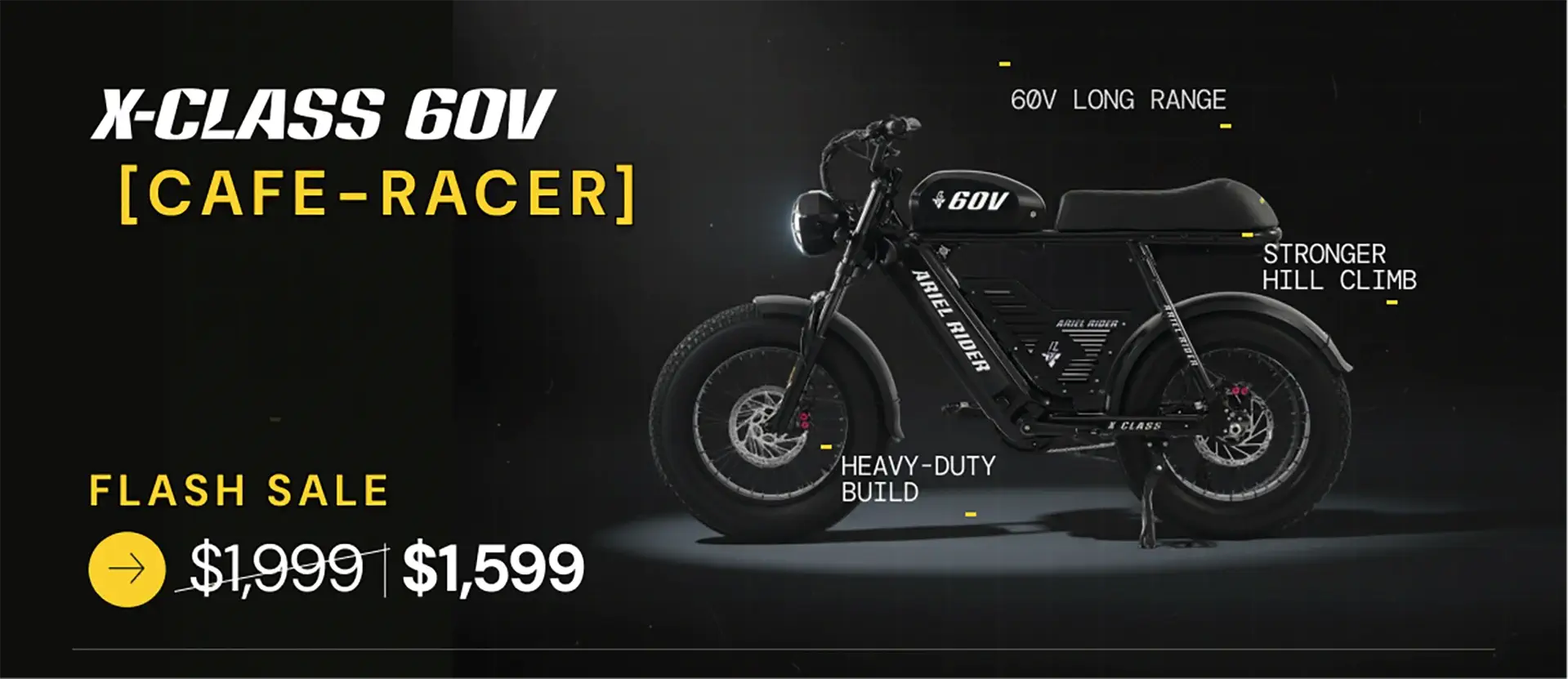E‑Bike Hill Climb Power & Speed Calculator
Pick your Ariel Rider model, choose a hill, and see real‑world climbing speed and battery use.
1. Set Gradient
2. Bike & Rider
Head-to-Head
| Model | Speed | Time to Top |
|---|---|---|
| Ariel Rider | -- | -- |
E-bikes & Hills: Frequently Asked Questions
1. How steep of a hill can an e-bike climb?
Most quality e-bikes can climb up to 15% grades without issue.
High-power models like the Ariel Rider X-Class 60V can handle even 20%+ grades, depending on rider weight and terrain.
2. What affects an e-bike’s hill climbing performance?
Key factors include motor power, battery voltage, rider and cargo weight, and tire traction.
Higher-voltage systems like 60V provide stronger torque for uphill acceleration.
3. Is 750W enough for climbing hills?
A 750W e-bike can manage moderate inclines (≈10%) but will slow on steeper roads.
The X-Class 60V system delivers higher current and torque for sustained uphill power.
4. Does motor voltage or wattage matter more for hills?
Voltage dictates how much torque your motor can sustain without overheating.
Higher voltage (52V–60V) generally outperforms higher wattage on steep grades due to better efficiency under load.
5. How do I know if my e-bike can climb the hills in my city?
Use the Hill Climb Estimator on this page — enter your weight and hill grade to see estimated speed and battery usage.
It’s tuned for real-world cities like Seattle, San Francisco, and Austin.
6. Does hill climbing drain the e-bike battery faster?
Yes. Uphill riding increases current draw, which uses more watt-hours per mile.
A 1-mile 10% climb may use 3–6% of total battery capacity on a 2100 Wh pack.
7. How can I make my e-bike climb hills better?
Keep your tire pressure correct, use a lower pedal-assist gear, and avoid sudden throttle bursts.
Performance-tuned e-bikes with 60V systems climb more efficiently by design.
8. What’s the best e-bike for steep hills?
Look for mid-drive or high-voltage hub-motor e-bikes.
The Ariel Rider X-Class 60V is built for torque and stability on 15–20% grades.
9. Does rider weight change climbing ability?
Yes — heavier loads increase required torque.
Our estimator adjusts for rider and cargo weight to show realistic speed outcomes.
10. How does the Ariel Rider X-Class 60V compare to other performance e-bikes on hills?
Compared to models like Super73 RX or ONYX RCR, the X-Class 60V balances high torque, throttle response, and battery endurance, offering a stronger sustained climb at typical rider weights.
Conquer every climb with confidence.
When it comes to e-bikes, not all hills are created equal—and not every motor can take them on. The Ariel Rider X-Class 60V was built for real-world performance, not lab specs. This Hill Climb Estimator helps you see how it actually performs where it matters most: your neighborhood’s steepest streets.
Just enter your weight and hill grade, choose a mode, and the tool gives you a simple, honest answer—no engineering degree required. Behind the scenes, it factors in torque, voltage, and battery capacity to estimate real-world climbing speed and battery draw. Whether you’re tackling the rolling slopes of Seattle, the sharp switchbacks of San Francisco, or the long grades outside Denver, you’ll know exactly what to expect before you ride.
Most 750 W e-bikes lose steam around 10 % grades, but the X-Class 60V’s high-voltage system delivers continuous power and strong throttle response even past 15 %. Its 60-volt, 35 Ah battery and torque-focused controller give you the punch to stay steady on climbs that stop smaller motors in their tracks.
Use this estimator to test different weights, hill angles, and modes—then compare against other performance e-bikes like the ONYX RCR, Super73 RX, or Lyric Graffiti. It’s a quick way to translate motor specs into what really matters: how fast you’ll climb and how much range you’ll use doing it.
So before your next ride, see how your bike stacks up. You’ll understand instantly why Ariel Rider’s performance models earn their reputation for torque, traction, and all-terrain attitude.



